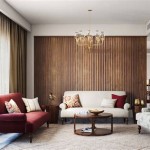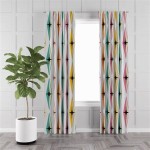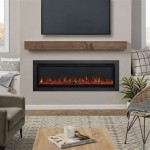Living Room Curtains with Matching Valance: A Complete Guide
Living room curtains and valances, when paired effectively, can significantly enhance the aesthetic appeal and functionality of a living space. They offer a coordinated look, providing both privacy and light control while contributing to the overall décor. This article explores the considerations involved in selecting living room curtains with a matching valance, covering aspects such as fabric choice, style options, and practical considerations for design and installation.
Understanding the Role of Curtains and Valances
Curtains serve multiple purposes in a living room. They regulate the amount of natural light entering the room, offering control over illumination levels throughout the day. During brighter hours, curtains can diffuse harsh sunlight, reducing glare and protecting furniture and flooring from fading. Conversely, at night, they provide privacy by obscuring the view from outside. From a design perspective, curtains contribute to the overall ambiance of the room through their color, pattern, and texture. They can soften architectural lines, add a touch of elegance, or inject a playful element into the décor, depending on the chosen style.
Valances, on the other hand, are shorter window treatments that typically sit at the top of the window. Their primary function is decorative, concealing curtain hardware such as rods and rings. They can also be used to create a more finished and polished look for the window. Valances come in a wide variety of styles, ranging from simple straight panels to more elaborate designs with swags, tails, and pleats. Selecting a valance that complements the curtains is crucial for achieving a cohesive and visually appealing window treatment.
The combination of curtains and a matching valance brings a sense of unity and completion to the window treatment. It suggests a deliberate design choice and elevates the overall sophistication of the living room. The valance acts as a frame for the curtains, highlighting their design and reinforcing the chosen style.
Selecting the Right Fabric and Style
The choice of fabric is paramount when selecting living room curtains and a matching valance. The fabric's weight, texture, and color will significantly impact the appearance and functionality of the window treatment. Heavier fabrics like velvet or brocade offer superior light blocking and insulation, while lighter fabrics such as linen or voile allow more light to filter through. Texture plays a crucial role in adding depth and visual interest to the room. Consider the existing décor and choose a fabric that complements the furniture, walls, and flooring.
Color is another critical factor. Neutral colors like beige, gray, and white are versatile and can easily blend with various design styles. Bold colors can add a pop of vibrancy to the room, but it is important to ensure they harmonize with the overall color scheme. Patterns can also be incorporated, but should be used judiciously. A busy pattern on both the curtains and valance can overwhelm the space. A general guideline is to use a patterned fabric for one element (either the curtains or the valance) and a solid-colored fabric for the other.
Style considerations extend beyond fabric and color. The style of the curtains and valance should align with the architectural style of the house and the overall design aesthetic of the living room. For example, a traditional living room might benefit from floor-length curtains with a tailored pleat and a classic swag valance. A contemporary living room might opt for simple, unlined curtains with a minimalist rod pocket valance. The length of the curtains is also important. Floor-length curtains create a more formal and elegant look, while curtains that fall just below the window sill offer a more casual and practical option.
Several valance styles are available, each offering a unique design element. A scarf valance is draped over a rod, creating a soft and flowing effect. A balloon valance is gathered at the bottom, creating a rounded, voluminous shape. A pleated valance features evenly spaced pleats for a structured and tailored look. A cornice is a rigid, box-like structure covered in fabric, offering a more formal and architectural element. The choice of valance style should complement the style of the curtains and the overall décor of the living room.
Practical Considerations for Design and Installation
Beyond aesthetics, several practical considerations should be taken into account when selecting and installing living room curtains and a matching valance. Measuring the windows accurately is crucial for ensuring that the curtains and valance fit properly. The width and length of the window should be measured, as well as the distance from the top of the window to the ceiling or crown molding. These measurements will determine the required fabric width and length, as well as the placement of the curtain rod and valance.
The type of curtain rod and hardware used will also impact the overall look and functionality of the window treatment. Decorative rods, such as wrought iron or wood, can add a touch of style to the room. Adjustable rods are ideal for windows of varying widths. Consider the weight of the curtains when selecting a rod. Heavy fabrics will require a sturdier rod to prevent sagging. The hardware used to hang the valance should also be considered. Brackets should be securely mounted to the wall to support the weight of the valance.
Lining curtains is another important consideration. Lined curtains offer several benefits, including improved light blocking, added insulation, and enhanced privacy. Lining also protects the face fabric from fading and adds body and structure to the curtains. Blackout linings are particularly effective for blocking out light in bedrooms or media rooms. Thermal linings can help to insulate the room, reducing energy costs. When selecting a lining, choose a fabric that complements the face fabric in terms of color and weight.
The installation process should be carefully planned. It is important to have the necessary tools and equipment, such as a measuring tape, level, drill, and screwdriver. The curtain rod and valance brackets should be securely mounted to the wall, ensuring that they are level and properly spaced. The curtains should be hung evenly on the rod, and any wrinkles or creases should be ironed out. The valance should be positioned above the curtains, concealing the curtain rod and hardware. Professional installation is recommended for complex window treatments or for those who are not comfortable with DIY projects.
Enhancing the Living Room with Layering and Accessories
Layering window treatments adds depth and dimension to the living room. Combining curtains with other window coverings, such as blinds or shades, offers greater control over light and privacy. Blinds can be used to filter light during the day, while curtains can be closed at night for added privacy and darkness. Shades can provide insulation and block out light, while curtains add a decorative touch. The choice of window coverings will depend on the specific needs and preferences of the homeowner.
Adding accessories can further enhance the look of living room curtains and a matching valance. Tiebacks can be used to hold the curtains open, allowing more light to enter the room. Decorative tassels and fringe can add a touch of elegance to the curtains and valance. Throw pillows and blankets in coordinating colors and patterns can tie the entire room together. The choice of accessories should complement the style of the curtains and valance, and should be used sparingly to avoid overwhelming the space.
Proper maintenance is essential for keeping living room curtains and a matching valance looking their best. Regular dusting or vacuuming will help to remove dirt and dust. Curtains should be professionally cleaned on a regular basis to prevent stains and fading. Valances should be spot-cleaned as needed. Following the manufacturer's instructions for cleaning and care will help to prolong the life of the window treatments.
Ultimately, selecting living room curtains with a matching valance involves careful consideration of fabric, style, practical considerations, and maintenance. By thoughtfully addressing these aspects, individuals can create a window treatment that enhances the beauty, functionality, and overall ambiance of their living space.

Valances And Shades For Living Rooms 38 Photos To Inspire You

7 Curtain Ideas To Lift Your Living Room Goodhomes Magazine

Valances And Shades For Living Rooms 38 Photos To Inspire You

Latest Curtain Designs For Dining Bedroom Light Luxury Color Matching High Precision Blackout Living Room Curtains And Price Made In Com

How To Style Curtains For Living Rooms Blinds Direct Blog

Mastering The Art Of Coordinating Curtain Colors Matching Tips Tricks Dolcewe

Curtains For Double Windows Side By Dolcewe

How To Choose The Perfect Curtains For Your Living Room

25 Captivating Living Room With Curtain Ideas

8 Modern Curtain Designs For Living Room Designcafe








